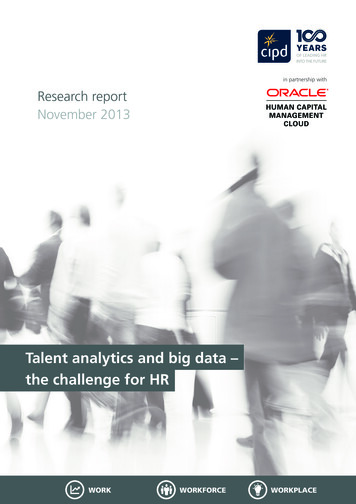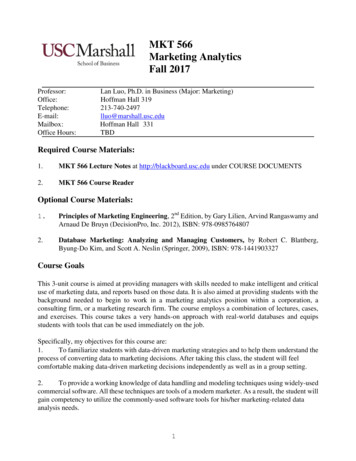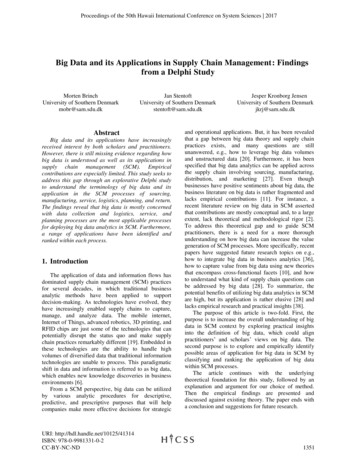
Transcription
The Big Book ofKey Performance IndicatorsbyEric T. PetersonBook Two in the Web Analytics Demystified SeriesFirst EditionPublished January 1, 2006Copyright 2005 Eric T. Peterson All Rights ReservedFor more information please visit http://www.webanalyticsdemystified.com
The Big Book of Key Performance Indicators isdedicated to Chloe and Cooper.
ForwardRarely do I see a client who doesn't have enough data, especially web data. It's widelyavailable. Yet, people are overwhelmed with it. The most sophisticated web analyticstools today now give you the flexibility to configure millions of custom metrics andreports. But who needs that many? How do you take advantage of that flexibility?This has created an interesting dichotomy. While the web analytics tools get richer withadvanced features, the vast majority of marketing executives and their organizations thatI work with are looking to simplify their analysis around specific, actionable objectivesand key performance indicators (KPIs) because they’re struggling to adequately quantifytheir results.So let’s start with the most high-level question, “How are we performing?”It’s a simple question, but a difficult one for marketers to answer. According to the CMOCouncil, 90 percent of senior marketing executives say measuring marketingperformance is a top priority, yet only 20 percent have a comprehensive metricsframework in place. This measurement gap is a direct reflection of the overwhelmingneed for clarity and best practices around defining KPIs.KPIs are the foundation to every successful web analytics solution. Having worked withseveral Fortune 1000 companies in the past few years that wanted to better use the webanalytics solutions they invested in, nearly all of them struggled with the samefundamental problem – a lack of agreed upon KPIs to prove and improve the results oftheir web business. Only in the hands of a seasoned business analyst, whether in-house oroutsourced, will an organization reap the additional benefits of the deeper ad-hoc analysiscapabilities that the web analytics tools provide. And, only after an organization hasclearly defined its objectives and established its scorecard of KPIs, does the moreadvanced analysis become a lucrative initiative.So what makes a KPI? Are there any standards or best practices? What are otherorganizations doing? These questions and many others will be addressed within thisbook.Read on to understand the criteria of what distinguishes a KPI versus other measures.You will find specific examples by industry and by site type. But, most importantly, youwill learn how to formulate your own KPIs for your specific business – setting thefoundation for your future success. And that’s what it’s really all about.Jason Burby, Director of Web Analytics for ZAAZ, jasonb@zaaz.comForwardi
ContentsForward . iContents . iiChapter 1 Introduction . 1Why this Book?. 2How This Book Is Designed to Evolve. 2Key Performance Indicators and Your Web Measurement Vendor . 3About the Use of Screenshots throughout This Book. 3Cookies and Key Performance Indicators. 3About the Author . 4Other Valuable References . 5Books . 5Web Sites, People and Groups. 5Chapter 2 Introduction to Key Performance Indicators. 7What is a Key Performance Indicator? . 7Definition . 8Presentation. 8Expectation . 10Action. 10What is not a Key Performance Indicator? . 11How Should Key Performance Indicators Be Presented?. 11Format . 11Contentsii
Timeliness of Delivery. 12Annotation. 12Who Gets What? . 13Seriously, Don’t Send Everyone 50 Key Performance Indicators! . 14How Should Key Performance Indicators Be Used?. 15How Should People Respond to Key Performance Indicators?. 16About Business Specific Key Performance Indicators . 16Chapter 3 The Indicators. 18Averages . 18Average Page Views per Visit . 19Average Visits per Visitor . 21Average Time to Respond to Email Inquiries. 23Average Cost per Visitor . 24Average Cost per Visit. 25Average Cost per Conversion . 26Average Revenue per Visitor. 27Average Revenue per Visit . 28Average Order Value . 29Average Items per Cart Completed. 31Average Clicks per Impression by Campaign Type (Click-Through Rate) . 32Average Visits Prior to Conversion . 33Average Searches per Visit. 34Percentages . 35Percent New and Returning Visitors. 35Percent New and Returning Customers . 37Contentsiii
Percent Visitors in a Specific Segment. 39Percentage of High, Medium and Low Time Spent Visits (Interest Categories) . 39Percentage of High, Medium and Low Click Depth Visits (Interest Categories) . 41Percentage of High, Medium and Low Frequency Visitors . 43Percentage of High, Medium and Low Recency Visitors. 45Percent Revenue from New and Returning Visitors and Customers. 46Percent Orders from New and Returning Visitors and Customers . 47Percent High and Low Satisfaction Visitors and Customers . 48Percent Visitors Using Search . 49Percent Zero Result Searches. 50Percent Zero Yield Searches. 51Rates and Ratios. 52Order Conversion Rate . 53Buyer Conversion Rate . 54New and Returning Visitor Conversion Rate . 55New and Returning Buyer Conversion Rate. 56Ratio of New to Returning Visitors . 57Order Conversion Rate per Campaign. 58Cart Start Rate. 59Cart Completion Rate . 60Checkout Start Rate . 61Checkout Completion Rate . 61Ratio of Checkout Starts to Cart Starts . 63Landing Page “Stickiness”. 64Information Find Conversion Rate . 66Contentsiv
Search to Purchase Conversion Rate . 67Search Results to Site Exits Ratio. 68Download Completion Rate. 70Form Completion Rate. 71Chapter 4 Key Performance Indicators by Business Type . 73Key Performance Indicators for Online Retailers. 74Recommended KPIs for Senior Strategists. 74Recommended KPIs for Mid-Tier Strategists. 76Recommended KPIs for Tactical Resources. 77Key Performance Indicators for Content Sites . 79Recommended KPIs for Senior Strategists. 79Recommended KPIs for Mid-Tier Strategists. 80Recommended KPIs for Tactical Resources. 81Key Performance Indicators for Marketing Sites . 83Recommended KPIs for Senior Strategists. 83Recommended KPIs for Mid-Tier Strategists. 85Recommended KPIs for Tactical Resources. 86Key Performance Indicators for Customer Support Sites. 87Recommended KPIs for Senior Strategists. 88Recommended KPIs for Mid-Tier Strategists. 89Recommended KPIs for Tactical Resources. 90Chapter 5 Parting Thoughts . 93How to Integrate the Use of Key Performance Indicators into your Organization . 93How to Get People to Care about Key Performance Indicators . 95Make the Data Easy to Understand. 95Contentsv
Talk about Business Problems, not Data . 96Be Inclusive . 96Remember, Your Visitors Are Real People!. 96Put Your Money Where Your Mouth Is . 97What Next? . 97Index . 98Contentsvi
IntroductionChapter 1IntroductionHaving spent most of my professional life in the web analytics field, either as aprogrammer, a consultant or an analyst covering the space, one of the things I have hadrepeatedly observed is that web analytics is not easy. No matter how simple and refinedthe interface or eloquent the explanation, most business people simply don’t seem to takethe time to understand the available data and try and use it to their advantage. But webdata is critical to the success of every online business, a truth that is proven again andagain every day. So the question becomes, “How can I make more people care about thedata that we mine from our web site?”How about making it easier for them to understand?The classic web analytics presentation includes pages and pages of data presented inworksheets and PowerPoint slides using domain-specific technical jargon, jargon thatmost normal people don’t understand. Often time’s web analytics salespeople will saywith all sincerity, “Our application is so easy to use that everyone in your company willwant to log in and use it!” Unfortunately, this is rarely true, and this type of thinkingusually leads to companies cycling through analytics vendors looking for “the rightinterface” and “the right reports.”For most people working in the online world, the “right” interface is an annotatedspreadsheet, slide or email. For nearly everyone, the “right” reports are the exact reportsthey need to succeed in their job, nothing more, and nothing less, presented in languagethat they understand. The former are generic and already universally deployed. Thelatter are specific to the business, the line of business and the stakeholder and need to beindividually deployed. The truth is that most people are unlikely to use a web analyticsapplication to do any type of meaningful analysis.So what can you do?Personally, I recommend key performance indicators and dedicated analytics expertise asa substitute for churning through applications in search of a silver bullet. Based on yearsof experience and volumes of research, the proper use of key performance indicators,managed by appropriate staff and widely distributed throughout the organization, doesmore to improve a company’s understanding of how the Internet impacts the overallbusiness than any attractive user interface or pretty graph. When companies proactivelydefine their business goals and the visitor activities that satisfy those goals, keyIntroduction1
Introductionperformance indicators become plainly obvious; when everyone is getting the “right” keyperformance indicator reports, everyone gets on the same page and the business begins tomake excellent use of their investment in web analytics.This book is all about key performance indicators—what they are, how they’re defined,how they’re used, who should use them—all of it. And if you’re serious about gettingmore from your investment in web analytics, read on!Why this Book?Having worked in the web analytics field since the late 1990s I have seen my fair share ofthe frustration and confusion that comes from an organization that intuitively knows theyhave a source of data that can drive business improvement but are unable to access andunderstand that data. Web analytics is powerful but nobody ever said it was easy.Fortunately I’ve been lucky enough to help companies establish key performanceindicators as a consultant and have seen how their use transforms people’s willingness touse data to make decisions. Kind of like turning an army of artists into an army of taxaccountants, allowing them to see beauty in the data.My successes with key performance indicators prompted me to write about them in bothmy previous books, Web Analytics Demystified (Celilo) and Web Site MeasurementHacks (O’Reilly), as well in a number of reports published by JupiterResearch. Talkingabout KPIs brought even greater interest in them as a subject and great interest in them onthe part of the vendor community. As more people began talking about KPIs, we allstarted notice that there was no definitive work on the subject, just my writing, ascattering of articles published by vendors and the occasional post to the Web AnalyticsForum at Yahoo! Groups.Since I’ve always been an entrepreneur, I saw an opportunity and thusly sat down towrite The Big Book of Key Performance Indicators. I was going to call the book PurpleData Cow or Who Moved My Spreadsheet? to be clever but I suspect it would haveseemed smarmy or worse, overbearing. For now this Big Book remains a small buthopefully exhaustive guide to the subject of key performance indicators. And hopefullyyou will respect my copyright and not share this book with your friends, asking theminstead to support the author, so my daughter can go to medical school and not have tosuffer sleepless nights writing like her dad.How This Book Is Designed to EvolveThe major reason that I have opted to only publish The Big Book of Key PerformanceIndicators as an electronic book is malleability; I want this book to get better over timeand not simply be the static document that Web Analytics Demystified and Web SiteMeasurement Hacks have become. To this end, I welcome any thoughts or experiencesyou’d like to share regarding your use of key performance indicators. Feel free to writeme anytime at eric@webanalyticsdemystified.com. My initial plan is to put out anIntroduction2
Why this Book?updated edition of this book once per quarter, free of course to everyone who has alreadypurchased a copy of the book.If you have a really great example, idea or insight, I’ll do my best to include yourexperience in a future edition of The Big Book of Key Performance Indicators.Key Performance Indicators and Your WebMeasurement VendorOne very important thing to know before getting into the subject of key performanceindicators is that your ability to use them is a direct function of your web analyticsapplication. Most of the data you’ll need to make the calculations in this book iscommonly available from nearly any web analytics application. But some data is onlyavailable from more complex applications, especially the segment-dependent KPIs. Ifyou have any questions about how to get the necessary data out of your particularapplication, I strongly encourage you to consult your application vendor directly. Ifthey’re not sure what you’re talking about, encourage them to purchase a copy of thisbook for their own bookshelves.About the Use of Screenshots throughout ThisBookRather than go through the process of requesting permission from dozens of vendors touse screenshots from their applications in this book to make a point, requiring legaldocuments and seemingly endless “bugging” on my part, I opted to use my own workwhenever possible and screen grabs from Google’s Google Analytics application. Ichose Google Analytics for one reason and one reason only—it’s free. This use is in noway, shape or form an endorsement of the application.You can learn more about Google Analytics at www.google.com/analytics/Cookies and Key Performance IndicatorsAll of the major web analytics applications rely primarily on browser cookies to stringmultiple page views together into visits and multiple visits into an individual visitor’shistory of activity on the web site. Unfortunately, consumers block and delete cookies,degrading the accuracy of cookie based tracking systems. While the whole cookie debateis outside of the scope of this book, I thought it worthwhile to point out where cookieblocking and deletion impact many of the KPIs I describe: Cookie blocking: Consumers preventing cookies from being “set” impacts mostcalculations dependent on “sessions” or “visits.” Some analytics applicationswill revert to less accurate methods than cookies to stitch subsequent page viewstogether into a visit; other applications simply drop visit data for browsers thatIntroduction3
Cookies and Key Performance Indicatorsdeny their cookies. The greatest impact from cookie blocking is observed inindicators like average page views per visit which are likely counting all of thepage views but missing any number of visits, having been dropped from theanalysis. Cookie deletion: Consumers erasing the analytics cookie from the computer’shard-drive, either manually or using some type of anti-spyware application,impacts any calculations dependent on “visitors.” Short-term measurements ofvisitors are less affected but as time goes on and more browser cookies aredeleted, visitors who have already been identified as having visited the sitepreviously appear to be new. The greatest impact from cookie deletion is on keyperformance indicators like average visits per visitor where the same personmight look like multiple visitors because a new cookie is being repeatedly set.Rather than provide a section in each indicator’s description talking about the riskassociated with data collection I would instead offer the following advice:1. Consult with your analytics vendor regarding their best practices policy forcookie use. Most will recommend using first-party cookies to minimizeautomated blocking and deletion activities. I strongly recommend followingwhatever advice your vendor provides, unless of course they profess noknowledge of problems associated with cookies, in which case I stronglyrecommend you find a new analytics vendor.2. Work to minimize risks associated with cookies by using first-party cookiesand by examining short timeframes whenever possible. One of the reasons Iadvocate reporting your KPIs on a daily or weekly basis is that it gives yourvisitors less time to delete cookies.3. Don’t stress out over cookie blocking and deletion. As long as you knowcookie deletion is happening you’re better off than any number of companies whostill don’t understand the problem. Plus, since key performance indicators aredesigned to highlight changes, their use is actually a brilliant strategy to mitigatethe ramifications of cookie blocking and deletion.For a more complete treatment of the problems with cookies and some alternatives Irecommend reading Hacks 15, 16 and 17 in my book Web Site Measurement Hacks. Thefirst discusses improving data accuracy using cookies, the second covers first-partycookies and the third alternatives to cookies. You can learn more about Web SiteMeasurement Hacks at my web site, www.webanalyticsdemystified.com.About the AuthorFor some reason I just can’t get enough of web analytics. I’ve written three books on thesubject Web Analytics Demystified (Celilo), Web Site Measurement Hacks (O’Reilly)and, of course, The Big Book of Key Performance Indicators. I have worked diligently tosupport the web analytics community by moderating the Web Analytics Forum at YahooIntroduction4
Cookies and Key Performance IndicatorsGroups, I maintain a big list of links to sites and articles about web analytics, and morerecently I’ve been promoting social networking events for web analytics professionals(Web Analytics Wednesday). You can learn more about my activities in this regard byvisiting my web site, www.webanalyticsdemystified.com.Other Valuable ReferencesWhile this book was written to be the definitive work, it is by no means the onlyinformation on key performance indicators available. The following are some othersources you should consider if you’re truly interested in the topic:BooksOne of my favorite books that cover key performance indicators extensively is Web SiteMeasurement Hacks: Tips & Tools to Help Optimize Your Online Business which Iauthored in 2005 with seventeen brilliant web analytics professionals. The entirety ofChapter 7, titled “Reporting Strategies and Key Performance Indicators,” provides muchthe same guidance I offer in this book. Web Site Measurement Hacks is well reviewedand available at just about any book store in the world, including Amazon.com, thanks tothe kind folks at O’Reilly & Associates.Another of my favorites, no big surprise, is my first book, Web Analytics Demystified: AMarketers Guide to Understanding How Your Web Site Affects Your Business. WebAnalytics Demystified provides an excellent introduction to the subject of web siteanalysis and measurement. In my freshman effort I examine the relevant metrics at eachphase in the customer life cycle—reach, acquisition, conversion and retention—recommending key performance indicators worth tracking at each phase. You canpurchase Web Analytics Demystified at Amazon.com or via my eponymous web site,www.webanalyticsdemystified.com.In addition to these fine books, many of the analytics vendors including WebSideStory(registration required) have published whitepapers on the subject that are available fordownload.Web Sites, People and GroupsAssuming you know about my web site, www.webanalyticsdemystified.com, there are ahandful of other sites, people and groups you should be aware of if you’re reallyinterested in the subject of key performance indicators: ZAAZ: The folks at ZAAZ make really good use of KPIs and you can learn moreabout their thoughts at www.zaaz.com. One of their principal analysts is JasonBurby who incidentally writes a column for the Clickz Network in which he oftencovers KPIs. You can see the breadth of Jason’s writing roduction5
Other Valuable References Bryan Eisenberg: Speaking of the Clickz Network, another of their authors,Bryan Eisenberg, is known to write about KPIs and extol their virtues at greatlength. Bryan is a true mover-and-shaker in the web analytics industry, cofounding the Web Analytics Association. You can read his Clickz work atwww.clickz.com/experts/author/index.php/19333 Web Analytics Association: Oh, and speaking of the Web Analytics Association founded in 2005 by Bryan Eisenberg and Jim Sterne, the group is providing allkinds of insight and education to those folks interested in the subjects of webanalytics and key performance indicators. Learn more about the group atwww.webanalyticsassociation.org Jim Sterne: And speaking of Jim Sterne Mr. Sterne is the Godfather of webanalytics, not because of his age but simply because of the clout he wields. Priorto having founded the Web Analytics Association with Bryan Eisenberg, Jim hadwritten dozens of books on web marketing and web analytics including one of themost important documents ever produced on the subject, E-metrics: BusinessMetrics for the New Economy. Jim hosts a few hundred really interested folksevery year at his E-metrics Summit in Santa Barbara, California and London,England. Learn how to join us at www.emetrics.org Jim Novo: One of Mr. Sterne’s good friends is Jim Novo, author of any numberof books on web analytics including Drilling Down: Turning Customer Data intoProfits with a Spreadsheet. Mr. Novo is an authority on key performanceindicators and his web site, www.jimnovo.com, is definitely worth checking out. Web Analytics Forum: As if this isn’t enough, you should know about the WebAnalytics Forum at Yahoo! Groups. A group that I had the pleasure of foundingin 2004 when I first published Web Analytics Demystified, the Forum iscomprised of well over 1,000 web analytics professionals around the globe askingand answering questions. Free to all comers, you can sign up atgroups.yahoo.com/group/webanalytics/.For more resources on key performance indicators please check out my web site,www.webanalyticsdemystified.com. Having purchased this book, you’ll have access toadditional information on the subject.Introduction6
Introduction to Key Performance IndicatorsChapter 2Introduction toKey PerformanceIndicatorsAs mentioned in the introduction, key performance indicators are a response to a gene
write The Big Book of Key Performance Indicators. I was going to call the book Purple Data Cow or Who Moved My Spreadsheet? to be clever but I suspect it would have seemed smarmy or worse, overbearing. For now this Big Book remains a small but hopefully exhaustive guide to











